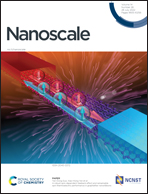Mercury-instructed assembly (MiA): architecting clathrin triskelion-inspired highly functional C3-symmetric triskelion nanotorus functional structures into microtorus structures†
Abstract
To detect heavy metal toxicity using self-assembled nanostructures, a clathrin triskelion-inspired highly functional C3-symmetric trimerized biotinylated di-tryptophan peptide was used. This triskelion peptide is known to self-assemble into nanotorus-like structures and can therefore act as a nanocage for various analytes. In this work, in addition to spectroscopy, force and electron microscopy were successfully used to detect the effect of toxic metal ions such as zinc, cadmium, and mercury by exploiting the change in the nanotorus morphology. Different concentrations of mercury led to the expansion of nanotorus structures into microtori. Therefore, we provide a unique application of heavy metal toxicity by utilizing “material nanoarchitectonics” to architect nanotorus structures into higher-order microtorus structures, as instructed by mercury. Such a strategy can make heavy metal sensing easier for materials scientists and open new avenues for biomedical/environmental science applications.



 Please wait while we load your content...
Please wait while we load your content...